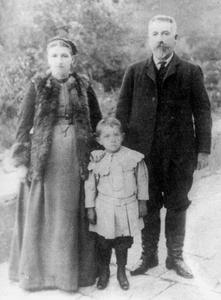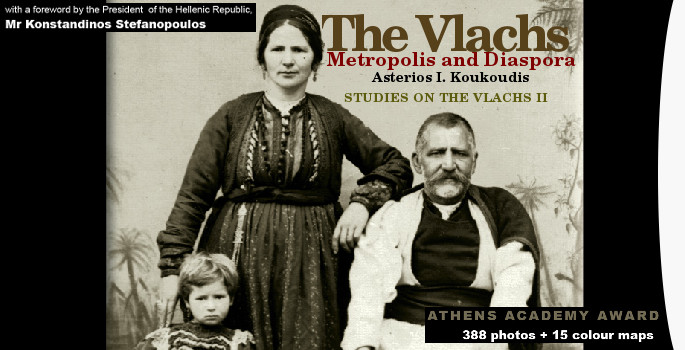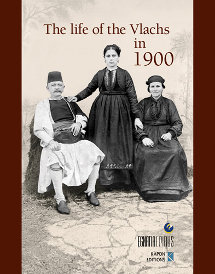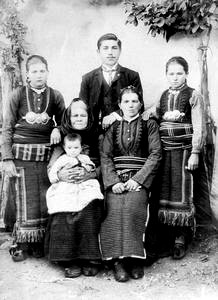THE VLACHS: METROPOLIS AND DIASPORA
I. The Vlachs of the Southern Pindos
The Vlachs of Aspropotamos and Malakassi
7.1 The conditions and the agents of development
 The difficult circumstances of the seventeenth century were succeeded by much more favourable conditions for the security and development of almost all the Vlach villges along the Pindos. However, the foundations of this prosperity and developmnent had been laid much earlier, despite the difficulties. Development came gradually and not simultaneously nor to the same degree in all the local Vlach villages. The basis of the economy in many of them was undoubtedly stockbreeding. Furthermore, many of them had been established when various stockbreeding clans and tselingata came together and evolved into more organised pastoral settlements. Simple katuns evolved into organised villages. Taking the cases of the best known and most important of the Vlach villages in the southern Pindos (Metsovo,[1] Syrrako,[2] and Kalarites[3] ) as examples, it is possible to form a more comprehensive idea of how the local Vlachs came to be among the fundamental agents of the economic and cultural renaissance and development of the modern Greek nation.
The difficult circumstances of the seventeenth century were succeeded by much more favourable conditions for the security and development of almost all the Vlach villges along the Pindos. However, the foundations of this prosperity and developmnent had been laid much earlier, despite the difficulties. Development came gradually and not simultaneously nor to the same degree in all the local Vlach villages. The basis of the economy in many of them was undoubtedly stockbreeding. Furthermore, many of them had been established when various stockbreeding clans and tselingata came together and evolved into more organised pastoral settlements. Simple katuns evolved into organised villages. Taking the cases of the best known and most important of the Vlach villages in the southern Pindos (Metsovo,[1] Syrrako,[2] and Kalarites[3] ) as examples, it is possible to form a more comprehensive idea of how the local Vlachs came to be among the fundamental agents of the economic and cultural renaissance and development of the modern Greek nation.
The massive population shifts in the highland communities from the very start of the Ottoman period and the, albeit only relative, security initially provided by self-administration and the armatoliks were the first factors in the development which burgeoned in the eighteenth century. Obviously, the poor mixed agricultural and pastoral economy of the highlands could not sustain the growing population. It was only when more favourable conditions were created for organising and developing stockbreeding that the Vlach villages were able to emerge from their economic standstill. All the same, we must not ignore the fact that almost all the Vlach villages in Malakassi and Aspropotamos kept up a certain degree of agricultural production commensurate with their economic development, which determined whether or not they needed to continue to work the land.[4] The notion that the Vlach communities have always been absolutely and exclusively involved in stockbreeding is a cliché that bears little relation to the facts. The identification of the Vlachs with stockbreeding, particularly its nomadic forms, was more a result of their historical, economic, and cultural development, as also of their adaptation to the environment and the general political circumstances. When one examines the cases of the Vlach villages of both the northern and the southern Pindos, it is easy to see how their economic circumstances and their struggle for survival led the Vlachs more than other groups to develop transhumant and nomadic stockbreeding practices and eventually to be identified so closely with them.
The more vigorous development of nomadic and semi-nomadic stockbreeding resulted in part from the fact that the conditions for the development of farming in the plains were destroyed. When the lowland villages passed into the hands of the spahis, agricultural production gradually declined or even ceased altogether. Vast lowland tracts lay uncultivated and turned into grassland. The depopulation of the plains provided a solution to the problems of overpopulation and survival in the mountains, for the highlanders were now able to develop more organised forms of stockbreeding, which required large winter pastures in the plains. The numbers of their rivals, the Yürüks, who were originally nomadic Turkic stockbreeders, had gradually fallen. At the same time, the Ottoman owners of the lowland pastures welcomed the nomadic and semi-nomadic stockbeeders as a source of extra income, renting them the lowland tracts that were lying idle. The ‘sheep tax’ that flowed into the coffers of the Ottoman state and the local governors also meant that the stockbreeders, whether Vlach or not, were regarded in a more positive light.
It is clear, then, that organised transhumant stockbreeding helped to create more favourable living conditions for the Vlachs. Affluence led to overpopulation, however, and created a need for new forms of economy. One segment of the Vlach population turned to craft-trades based on the products of stockbreeding. The home manufacture of woollen fabrics, which had initially been a matter of survival, became a mass commercial enterprise, and led to standardisation and to the manufacture of clothing. From the splendid rough woollen cloth called skouti they produced their famous kapes, rough sleeveless overcoats much favoured both by shepherds and by sailors. However, the rigid system of the tselingata proved socially and economically stifling for many of their members. The situation was somewhat eased when, having reached an impasse, many of the less privileged members decided to go in for transportation. Since they already possessed large herds of pack-animals, which they used during their seasonal movements between summer and winter pastures and also for supplying their highland villages and keeping the passes open, they decided to operate professionally, transporting the light industrial goods produced in the villages, other commodities, goods, and people through the mountain passes in the Pindos. Some of the muleteers and caravan-drivers (kyradzides) soon opened khans, inns, and wine shops in the economic and administrative centres and also along the Balkan highways as far as Belgrade and Bucharest. At the same time, members of the tselingata gradually turned themselves from transporters into capitalist merchants trading in the woollen articles produced in the local light industrial units, and later evolved into retailers and dealers in all kinds of goods. This was how the caste of the famous itinerant traders (pramateftades) came into being.[5] In the nineteenth century, when cotton seemed to be overtaking wool in terms of marketability and profit, they became cotton merchants and exported it to the West. And they did the same with tobacco at the end of the nineteenth century.
In order to distribute their merchandise and further develop their commercial activities, they journeyed all over the Ottoman Balkans. Many gradually settled down, mainly in towns in Thessaly and Epiros. Small groups settled in the Empire’s large urban centres, even as far afield as Constantinople, or Polea, as the Vlachs call it. In Ioannina (Ialna) and Trikala (Trikolou) they competed with, or even ousted, the older groups of urban merchants.[6] From at least the mid-eighteenth century, the leading families of Aspropotamos, such as the Dimakises of Haliki, the Papapolymerous and the Dimakises or Papadimases of Kastania, and the Hadzipetroses of Neraïdohori, made up a very significant proportion of the Christian gentry of Trikala, occupying or even monopolising the positions of the kocabasis of the town.[7] Merchants from Kalarites traded in skouti from the Vlach villages in both the southern Pindos and the Olympos area.[8] The enterprising families of the wholesale merchants and the kocabasis, as also of the poorer traders and craftsmen who settled in the towns and established family networks, played an active and decisive role in shaping the modern Greek urban class in Epiros, Thessaly, and Macedonia.[9]
A typical case is Ioannina, where Vlach traders and craftsmen mainly from Vlahodzoumerko (Kalarites and Syrrako) and Hora Metsovou settled and became very active in economic, corporate, and communal affairs. The same applies to the Lambros, Tourtouris, Sgouros, and Damiris families from Kalarites, who apparently supplanted older Ioanniot craftsmen in the Ioannina market in the time of Ali Pasha. There were a considerable number of Vlachs in the echelons of Ali’s crowded and much talked-about court, from the humble Metsovite porters who bore his litter on their shoulders to secretaries like Hristodoulos Hadzipetros from Neraïdohori in Aspropotamos (later King Otto’s aide-de-camp), the inspector of the Ioannina market Anastassios Samariniotis, privy councellors like the wealthy merchant Yeoryios Tourtouris from Kalarites, and European-trained doctors like Ioannis Kolettis from Syrrako (later Prime Minister of Greece) and Yeoryios Tsapraslis from Kalarites (who wrote one of the first grammars of the Vlach language). Vlachs from Kalarites, Syrrako, and Metsovo settled en masse in Ioannina and played an active part in revitalising that ruined town after the Greek War of Independence.[10]
Apart from the various craft-trades based on livestock products, other forms of light industry which had disappeared or could not develop in the lowland villages and most of the urban centres survived and developed in the Vlach villages. Apart from considerable mass production of, and trade in, dairy products, some Vlach villages, such as Kalarites and Syrrako, made a name for themselves by developing gold- and silverwork, metalwork, and tailoring.[11] Logging led to the production of wooden implements and other articles and gradually to the development of wood-carving and the production of chancel screens for churches. The fame of the Metsovite wood-carvers and joiners took them as far afield as Philippopolis (Plovdiv). There were also famous coopers, farriers, saddlers, and shoemakers; famous teams of builders and carpenters were set up; tailoring begat the specialised craft of gold embroidery.[12] All these craft-trades provided an outlet for the inhabitants who did not have an active place in the system and castes of the tselingata and the wholesale merchants.
During the eighteenth century, and especially from 1760 onwards, the people of Malakassi and Aspropotamos followed the example of the Moschopolitan Vlachs and took their merchandise in caravans to the commercial towns of Central Europe. They also took advantage of burgeoning Greek shipping to cross the seas and establish commercial firms and colonies in the Mediterranean ports. Merchants from Metsovo, Kalarites, Syrrako, and the kefalohoria of Aspropotamos went as far as Cadiz, Sardinia, Genoa, Leghorn, Naples, Malta, Ancona, Venice, Trieste, and Dubrovnik. They travelled to the Danubian Principalities, Vienna, and Moscow, and settled there. It is revealing that in the membership lists of the Filiki Etairia (1816–21), the various Epirots include a considerable number of Vlach merchants hailing from Metsovo, Milia near Metsovo, Kalarites, Syrrako, Moschopolis, and Ioannina, who were living in Odessa, Moscow, Warsaw, Trieste, Turnu Severin, Bucharest, Galati, Jassy, Reni, Naples, Constantinople, and Alexandria.[13] When Egypt became the new Eldorado in the early nineteenth century, the Vlachs were among the first to play a fundamental part in establishing the Greek colonies there.[14]
They returned to the Vlach villages in the Pindos bringing with them not only economic wealth, but also cultural and intellectual regeneration and development. The Vlach villages were transformed into organised little towns and presented a picture that was quite unprecedented for most of the modern Greek nation that was then taking shape. In Kalarites one could find strong money-lending organisations and find out how the European stock exchanges were faring, and, as Leake tells us, nowhere else did one find such secure credit as in Kalarites. The well-travelled Vlach traders spoke many European languages and were reportedly among the few competent people in the Balkan hinterland with whom the western merchants could work and liaise. French merchants, for instance, established the large warehouses they needed for their merchandise in Metsovo as early as 1719. The Vlach villages had large libraries, well stocked with volumes in both Greek and other languages, a rare phenomenon in those days. Pouqueville was impressed by the orderliness and harmony which reigned in Kalarites, as also by the strict regulations which had been adopted against ostentatious luxury and extravagant dowries and for the support of local products. The Vlach women were no less industrious than the men, and the poorest of them did not object to working even as porters. According to Pouqueville’s estimates, in around 1814 the value of the flocks and herds of the Vlach communities all along the Pindos was about 40,000,000 piastres, while those of Ali Pasha were worth no more than about 2,000,000 piastres.[15]
Passing through the Vlach villages in around 1812–13, Henry Holland noted that the most important Vlach towns were engaged in wool production or in some branch of overland trade and that the inhabitants had the reputation of being among the best craftsmen in Greece. He also observed an air of industry, decorum, and order in the towns, which not only distinguished them from all the other towns in the southern Balkans, but also stood in stark contrast to the wild, rough landscape which surrounded them.[16]
Equally interesting is William Leake’s observation that, though the Vlachs were less sharp-witted than the Greki, they were more steady, prudent, and persevering, though rarely free from internal intrigue, discord, and division.[17]
Pouqueville in his turn notes that,
they are accused of being excessively tight-fisted and obstinate, yet in these rustic ways of theirs we nonetheless discern an unprecedented candour, which is not found in the Levantine character.[18]
Apart from the personal wealth and the highly developed sense of social organisation that characterised most of the Vlach villages, they displayed a general air of communal prosperity. During the eighteenth century, almost all the Vlach villages in the southern Pindos built at least one new church, all of them quite splendid for the time. Those churches, together with the numerous and once rich local monasteries, still stand as irrefutable witnesses to that glorious era.[19] It would probably be superfluous to go into the details of how Greek education developed in the same period in the Vlach kefalohoria in the southern Pindos. Schools like the one at Metsovo were acclaimed centres of the modern Greek Enlightenment, with outstanding teachers of both Vlach and other origin.[20] In view of all this, one might say that the Vlachs contributed even more to the cultural shaping of the modern Greek nation than to the wars and rebellions; and this at a time when the modern Greeks were still seeking and shaping a new Greek identity.
[1] Leake, op. cit., pp. 101-4; Rokkou, V., Υφαντική οικιακή βιοτεχνία, Μέτσοβο 18ος – 20ος αιώνας, Ioannina Centre for Research into Tradition and Culture, Athens 1994.
[2] Krystallis, op. cit.; Moustakis, G., ‘Το Συρράκο και η Πρέβεζα’, Prevezanika Hronika, Nos. 27-28, Jan.–Dec. 1992, pp. 177-214; Karadzenis, N. V., Οι νομάδες κτηνοτρόφοι των Τζουμέρκων, Arta 1991.
[3] Pouqueville, F., Ταξίδι στην Ελλάδα, Ήπειρος, Tolidis, Athens 1994, pp. 287-319; Leake, op. cit., pp. 88-98, 186-90. For more information on Metsovo, Syrrako, and Kalarites see Vakalopoulos, K., Ήπειρος, Kyriakidis Bros., Thessaloniki 1992, pp. 392-7.
[4] For the agricultural economy in the Vlach villages see Kaloussios, D. G., Το Ματσούκι Ιωαννίνων, vol. 1, Ιστορικά, vol. 2, Λαογραφικά, Matsouki and Trikala 1994.
[5] Faltaïts, K., Οι πλανόδιοι Ηπειρώται τεχνίται και η εθνική μας υπόθεσις, Athens 1928.
[6] Vakalopoulos, K., Ήπειρος, Kyriakidis Bros., Thessaloniki 1992, pp. 73-4; Papayeoryiou, Yeoryios, Οι συντεχνίες στα Γιάννενα κατά τον 19ο και τις αρχές του 20ου αιώνα, doctoral thesis, 2nd edition, Institute for the Study of the Ionian and the Adriatic 10, Ioannina 1988, pp. 47, 104-17.
[7] Papanikolaou, N. G., Καστανιά, το χωριό μου, Trikala 1997, pp. 179-89.
[8] Moustakis, op. cit., p. 203.
[9] Pouqueville, op. cit., pp. 307-8; Leake, op. cit., pp. 90-1.
[10] Papayeoryiou, op. cit., pp. 45-7, 51-2, 60, 108, 112, 173-4, 180, 237.
[11] On the goldsmiths and cape-makers of Kalarites and Syrrako, see Papayeoryiou, op. cit., who refers to: Faltaïts, K., ‘Οι πλανόδιοι τεχνίτες στην Ελλάδα’, Ellinika Grammata, vol. 3, No. 1 (25), 16 June 1928; Faltaïts, K., ‘Καποτάδες ― Τερζήδες και Καζάζηδες’, Ellinika Grammata, 1 July 1928; Zora, Popi, Δύο μεγάλοι μάστοροι του ασημιού, Αθανάσιος Τζημούρης – Γεώργιος Διαμαντής Μπάφας, Athens 1972; Konomos, Dinos, Ηπειρώτες στη Ζάκυνθο, Ioannina 1964.
[12] Hadzimihali, Angeliki, ‘Ραφτάδες – χρυσορραπτάδες και καποτάδες’ in the collective work Αφιέρωμα στη μνήμη του Μανόλη Τριανταφυλλίδη, Athens 1960, pp. 445-74.
[13] Aravandinos, P., Περιγραφή της Ηπείρου εις μέρη τρία, part 3, Society for Epirot Studies, Ioannina 1984, pp. 337-9; Vakalopoulos, Ήπειρος, op. cit., pp. 211-16.
[14] The early protagonists included Kyriakos Tassikas, a merchant whose family hailed from the Vlach villages of Aspropotamos, Mihaïl Tositsas, the national benefactor from Metsovo and personal friend and close associate of the Moslem Albanian ruler of Egypt, Mohamed Ali, and the Patriarch of Alexandria, Hierotheos I, who hailed from Klinovos in Aspropotamos and occupied the patriarchal throne from 1825 until his death in 1844.
[15] Pouqueville, op. cit., pp. 307-12; Arseniou, op. cit., pp. 54-9, 70, 77-83, 94-5; Pouqueville, F., Ταξίδι στην Ελλάδα, Στερεά Ελλάδα – Αττική – Κορινθία, Gr. tr.: Mirka Skara, Tolidis Bros., Athens 1995, p. 216. For an account of Pouqueville’s notes on the Vlachs, see Simopoulos, Kyriakos, Ξένοι ταξιδιώτες στην Ελλάδα, 1810-1821, vol. III 2, 4th edition, Athens 1992, pp. 341-9.
[16] Holland, H., Ταξίδι στη Μακεδονία και Θεσσαλία, 1812-1813, Tolidis Bros., Athens 1989, p. 64.
[17] Leake, op. cit., p. 86.
[18] Pouqueville, op. cit., p. 348.
[19] Nimas, T. A., Τρίκαλα, Καλαμπάκα, Μετέωρα, Πίνδος, Χάσια, Kyriakidis Bros., Thessaloniki 1987, pp. 235-79.
[20] Hadzimihali, Angeliki, Οι εν τω Ελληνοσχολείο Μετσόβου διδάξαντες και διδαχθέντες, Ioannina 1939, and in Ipirotika Hronika, 1940; Ziagos, N. G., Τουρκοκρατούμενη Ήπειρος. Τιμαριωτισμός, αστισμός, νεοελληνική αναγέννηση (1648-1820), Athens 1974. For Greek education in Aspropotamos, see Nimas, Theodoros A., Η εκπαίδευση στη Δυτική Θεσσαλία κατά την περίοδο της Τουρκοκρατίας, Kyriakidis Bros., Thessaloniki 1995.







